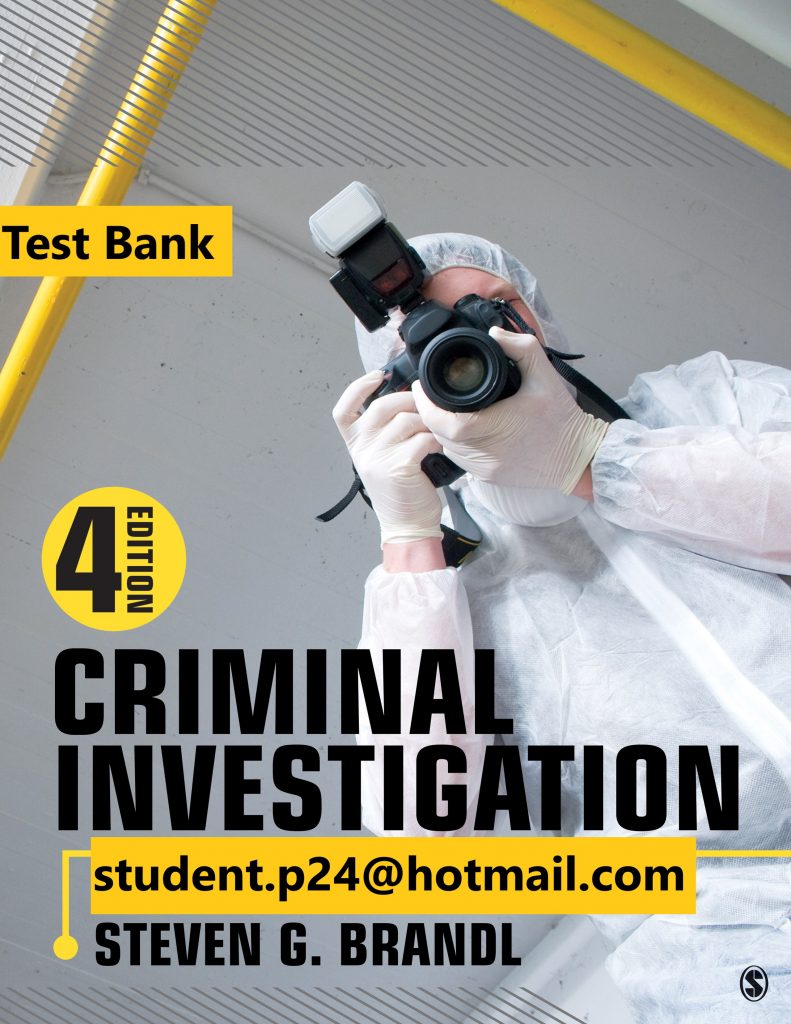Test Bank Criminal Investigation Fourth 4th Edition by Steven G. Brandl 2018 ( SAGE Publisher ) Test Bank

Test Bank
- Publisher: SAGE Publications, Inc; 4 edition (December 19, 2017, )
- Language: English
- ISBN-10: 1506391419
- ISBN-13: 978-1506391410
its the TEST BANK
To request it .. Please contact us via e-mail
[email protected]
or you can use form contact by this link :
https://buy-testbank.com/contact-us/
Example:
Hi ,
book name :
IMPORTANT **
You will receive a response from us, just by this email ..
[email protected]
or
[email protected]
any other email address , it not us.
DESCRIPTION
New to the Fourth Edition:
- New and updated statistical information, research findings, investigative procedures, and legal cases ensure students are learning about the most current research in the field.
- Several new “From the Case File” chapter introductions and 25 new in-chapter “Case-in-Point” investigative case examples make it easier for students to connect the content to the real world.
- More than 75 new photos, most of which are case photos from actual investigations, illustrate key concepts to help keep students engaged with the content.
- New material on documenting evidence via reports provides examples of well-written police reports to help students build better writing skills.
- New material on social media and evidence from electronic digital devices discusses how to use new technology as a source of information.
- A stronger focus on terrorism and the use of technology in investigations encourages students to discuss and critically analyze the future of criminal investigations.
- New sections titled “Mental Mistakes in Criminal Investigations,” “Perspectives on the Criminal Investigation Process,” and “Qualities and Characteristics of Investigators” offer students tips and advice for conducting successful investigations.
- New material on touch DNA helps students see the benefits and limitations of scientific evidence gathered from a crime scene.
Give your students the SAGE edge!
SAGE edge offers a robust online environment featuring an impressive array of free tools and resources for review, study, and further exploration, keeping both instructors and students on the cutting edge of teaching and learnin
Table of Contents
, Also .. you can check our full list there :
list of Solution manual and Test Bank Part 1
and
list of Solution manual and Test Bank Part 2
and
list of Solution manual and Test Bank Part 3
————————————————————————————
What is SM, TB , IM ?
· What is the Test Bank (TB)?
An ever-expanding collection of previously administered exams, quizzes, and other assessment measures in a wide range of courses made available for current students as study aids.
Why should I use previously administered tests to study?
* become familiar with how material will be tested
* see the format of the test
* practice test-taking skills
* simulate a timed exam
* gain more experience with course content
· What is a SOLUTION MANUAL (SM)?
A Solutions Manual contains all the answers to the questions in the book with detailed explanations and examples.
· What is an INSTRUCTOR’S SOLUTION MANUAL (ISM) OR INSTURCTOR’S MANUAL (IM)?
An Instructor’s Manual is the guide that your teacher may use when making lesson plans and contain extra questions and answers, lab assignments, and more.
Note:
All solutions manual and Test Banks be in soft copy [Adobe Acrobat Reader (PDF )or Word format .Docx]
Best wishes,
Student Saver Team ,
================